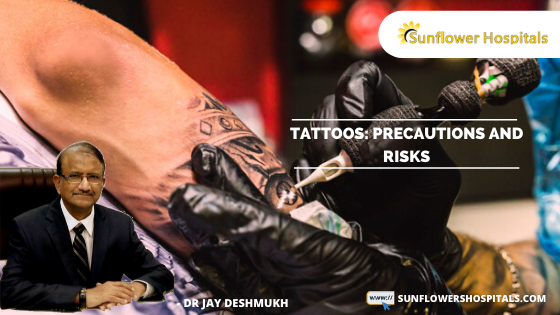How should counselling be done about tattoos?
Clinicians, teachers, and parents may be the first and only source of credible information about a tattoo for children and adolescents. There is a regulation for age as well. It is suggested that parents or some responsible person accompanies the individual for the tattooing session. Tattooing is not entirely safe and can be responsible for local allergies, keloid formation or transmission of infections.
What are the relative contraindications to obtaining a tattoo?
If the person is immuno-logically compromised due to severe diabetes, on steroids or has had an organ transplant, tattoo-ing should be best avoided. History of keloid formation is important, as keloids may be formed in the tattoos. Oral therapy for acne with isotretinoin delays healing time. Patients with certain skin conditions like psoriasis, lichen planus, vitiligo, and discoid lupus should avoid tattooing.
How is tattooing done?
The skin is cleaned with an alcohol and iodine solution. Tattoo design is made on the skin. Most commercial artists apply ink using a handheld electric powered machine. Several needles are attached to the end of the needle bar that moves up and down 50 to 3000 times per minute. The needles are responsible for inserting the pigment in the skin. The depth of the puncture varies from 1 to 4 mm.
What are the tattooing ink or colouring agents?
The colouring agents include inorganic metallic salts, different types of organic molecules and organic dyes. The composition of the inks has changed. Now cadmium, cobalt and mercury are less in use. Metallic salts are still being used.
What are the local reactions seen after tattooing?
Local allergic reactions are possible. Sarcoidosis type, scleroderma type and recurrent infections are possible. Retold formation or a scar formation is possible. Temporary henna tattoos are safe, but black henna tattoos can cause problems due to a chemical known as para-phenylenediamin, which can cause allergy.
What are some other infections transmitted by tattooing?
People exposed to unhygienic tattooing studio at a fare or exhibition or at some mela and those who do not follow after-care instructions can get serious issues. These include hepatitis B or C infection, HIV infection or infective endocarditis. Septicaemia can occur in individuals with poor immunity. In individuals with deficiency of glucose-6-phosphate dehydrogenase, red henna may precipitate severe destruction of red blood cells.
What are some other issues with tattooing?
In individuals with tattoos, an MRI scan may cause burning sensation at the tattoo site because of the metals involved in the tattooing ink. Some tattoo pigments may contain cadmium or cobalt. They are carcinogenic. But association of tattoos and cancer is not proved.
What about tattoo removal?
Tattoo removal is more expensive, time consuming and unpleasant procedure. Laser therapy is used to remove tattoos. This requires many sessions but total removal is not guaranteed. In the past, cryosurgery, thermal cautery or surgical resection has been tried. All methods are known to leave a scar or some pig-mentation. Tattooing is quite a fash-ion these days. The procedure and some perceived complications should be known to all. The risk of infections are low if sterile precautions are used. Completing hepatitis B immunisation before tattooing is suggested. Removal of a tattoo is more costly than its application.

